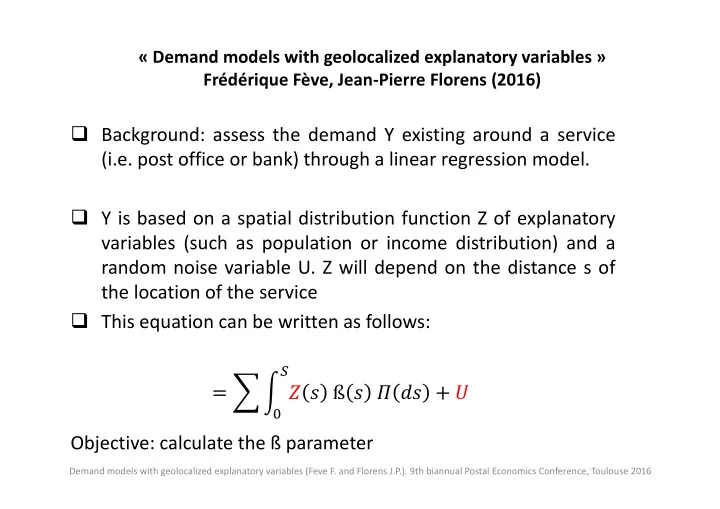

« Demand models with geolocalized explanatory variables » Frédérique Fève, Jean ‐ Pierre Florens (2016) Background: assess the demand Y existing around a service (i.e. post office or bank) through a linear regression model. Y is based on a spatial distribution function Z of explanatory variables (such as population or income distribution) and a random noise variable U. Z will depend on the distance s of the location of the service This equation can be written as follows: � � � � � � ß � � �� � � � Objective: calculate the ß parameter Demand models with geolocalized explanatory variables (Feve F. and Florens J.P.). 9th biannual Postal Economics Conference, Toulouse 2016
Z and U exogeneous: E(Z,U)=0 Calculation of the regularisation parameter α of ß α through Tikhonov • regularisation: � 2 α = arg min �yi � � zi, ß α �2� �� �� � � ��� • ß estimation through Tikhonov regularisation with optimal α => β estimated and β actual curves very similar Demand models with geolocalized explanatory variables (Feve F. and Florens J.P.). 9th biannual Postal Economics Conference, Toulouse 2016
Z and U endogeneous: E(Z,U) ≠ 0 Instrumental variable W introduced • Calculation of the regularisation parameter α of ß α through Tikhonov • regularisation ß estimation through Tikhonov regularisation with optimal α • => β estimated and β actual curves less similar Demand models with geolocalized explanatory variables (Feve F. and Florens J.P.). 9th biannual Postal Economics Conference, Toulouse 2016
Comments & Questions Interesting approach to analyse demand of a specific service with a relevant implementation on public hospitals Use of strong methods in econometrics and analysis carried out in a systematic manner Should be clearer as to why both cases (exogeneity and endogeneity) have been considered Rather concerned about using euclidean distance s on the simulation in urban area rather than travel time or generalised cost (car or public transport) as results must be significantly different especially in peak periods Why does the hospital capacity curve show a second peak at km 45 ‐ 50 in a urban zone? Demand models with geolocalized explanatory variables (Feve F. and Florens J.P.). 9th biannual Postal Economics Conference, Toulouse 2016
Recommend
More recommend